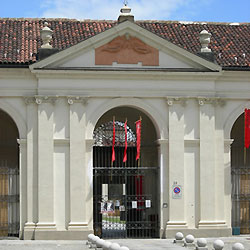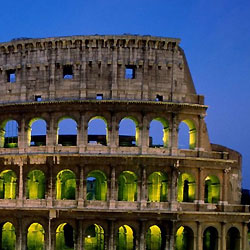Rome Half Day Tours
Rome By Night | Monumental | Vatican
Monumental Rome Half Day Tour
The capital of Italy is probably the most visited city in the world. Whilst, arguably, for the Italians Rome is primarily the political centre of the nation, for others it is its wealth of architectural and artistic treasures which makes it a truly remarkable and unforgettable city. The numerous museums, monuments and churches, not to mention the archaeological sites, represent a cultural heritage so vast that a whole lifetime would not be sufficient to explore it in its entirety.
This is why if you visit the city of Rome…non basta una vita per visitarla, is not enough a life time to visit the Eternal City.
Suggested 5 hours tour of Rome with the visit of the St, Peter in Chain, Coliseum, Arch of Constatine, Capitol Hill, Roman Forum, Trevi Fountain, Spanish Steps, the Pantheon and Piazza Navona, the service is driver/guided and is individually personalized.
Rome By Night | Monumental | Vatican
Monumental Rome Half Day Tour
The capital of Italy is probably the most visited city in the world. Whilst, arguably, for the Italians Rome is primarily the political centre of the nation, for others it is its wealth of architectural and artistic treasures which makes it a truly remarkable and unforgettable city. The numerous museums, monuments and churches, not to mention the archaeological sites, represent a cultural heritage so vast that a whole lifetime would not be sufficient to explore it in its entirety.
This is why if you visit the city of Rome…non basta una vita per visitarla, is not enough a life time to visit the Eternal City.
Suggested 5 hours tour of Rome with the visit of the St, Peter in Chain, Coliseum, Arch of Constatine, Capitol Hill, Roman Forum, Trevi Fountain, Spanish Steps, the Pantheon and Piazza Navona, the service is driver/guided and is individually personalized.
| St. Peter in Chains. San Pietro in Vincoli (Saint Peter in Chains) is a small basilica in Rome, founded in the 5th century to house the reported chains that bound St. Peter in Jerusalem. Even more famous than the chains of Saint Peter is Michelangelo's statue Moses, part of the Tomb of Pope Julius II. The basilica was first built in the middle of the 5th century to house the relic of the chains that bound Saint Peter while imprisoned in Jerusalem. According to legend, when Empress Eudoxia (wife of Emperor Valentinian III) gave Pope Leo I the chains as a gift, he compared them to the chains of St. Peter's first imprisonment in the Mamertine Prison in Rome and the two chains miraculously fused together. The chains are kept in a reliquary under the main altar in the basilica. The basilica has undergone several restorations and rebuildings, including a restoration by Pope Adrian I, a rebuilding by Pope Sixtus IV and another by Pope Julius II. There was also a renovation in 1875. Some modernizations were made at that time. Michelangelo's Moses, which dates from 1515, is the most notable piece of artwork in the basilica. Originally intended as part of a 40-statue funeral monument for Pope Julius II, "Moses" became the Pope's funeral monument and tomb in his family's church. |
 |
| Coliseum, Arch of Constantine and Capitol Hill. The Anfiteatro Flavio, known throughout the world, the Coliseum is symbolic of the city of Rome. It is 50 meters high, 86 meters long and 54 meters wide, distributed on a structure of elliptic form. It was built under the rule of the Emperor Vespasiano on an artificial lake in 79 A.D. The Coliseum was inaugurated by Tito and became the theatre of frighteningly cruel games, in which gladiators fought each other and lions were let loose on human beings who were destined to be mauled to death. In the lower part of the Coliseum one can see the underground passages and the tunnels where the lions were kept. The Coliseum was later used as a source of materials for building works. Near to the Coliseum one finds Costantino's Arch which has to be the best example of the "recycling" carried out during the crisis of the Massenzio Empire in 312 A.D. The Domus Area, once the residential quarters of Nerone which were built after the terrible fire of 64 A.D., is close by in the Colle Oppio Park.Piazza del Campidoglio originates from a design by the great Michelangelo Buonarroti, facing San Pietro, with an equestrian statue by Marco Aurelio at its center, transfered here in 1538 from the Laterano on the request of Pope Paolo III. In the Piazza del Campidoglio one finds Palazzo Senatorio, work of Giacomo Della Porta and Girolamo Rainaldi, in which Rome's County Council meets; Palazzo Nuovo, designed by the Rainaldi Brothers; Palazzo dei Conservatori, the construction of which was initiated by Michelangelo Buonarroti and completed by Giacomo Della Porta; the Pinacoteca Capitolina, which houses an impressive collection of paintings from the Middle Ages to the late XVIII century, including works by Titian, Veronese, Rubens, Caravaggio and Pietro da Cortona. Within the vicinity of Piazza del Campidoglio one can visit the medieval Church of St Maria in Aracoeli, the Fortuna Virile Temple, the Vesta Temple, the Church of St Maria in Cosmedin, the Church of St Sabina and the Church of St Alessio and Bonifacio. |
 |
| Pantheon. Agrippa's Pantheon is situated in Piazza della Rotonda. The Pantheon, meaning the "consecrated temple of all divinities", was built under the rule of the Emperor Adriano between 118 and 125 A.D. This has to be the monument which best represents Roman architecture. Here revolutionary elements were introduced, such as the combination of a round building, covered by a perfectly hemispherical dome, and a rectangular pronaos and colonnade more than 33 meters wide. Light enters through a hole right in the center of the dome of 9meters diameter. The building has been preserved largely because it was transformed into the Church of St Maria ad Martyres during the transition from Pagan to Christian Rome. Vittorio Emanuele II, Umberto I, Margherita di Savoia and the painter Raffaello Sanzio are buried here. In the same area as the Piazza della Rotonda and the Pantheon, one can also visit the Churches of St Maria sopra Minerva, St Maria della Maddalena, St Luigi de'Francesi, St Ivo alla Sapienza and St Andrea della Valle. |
 |